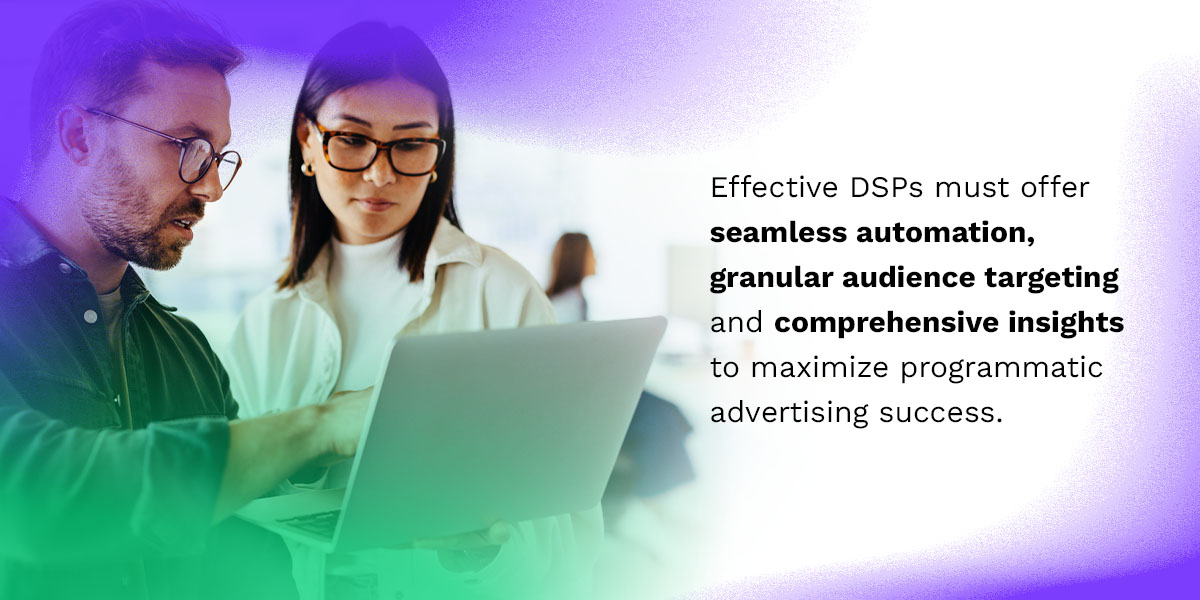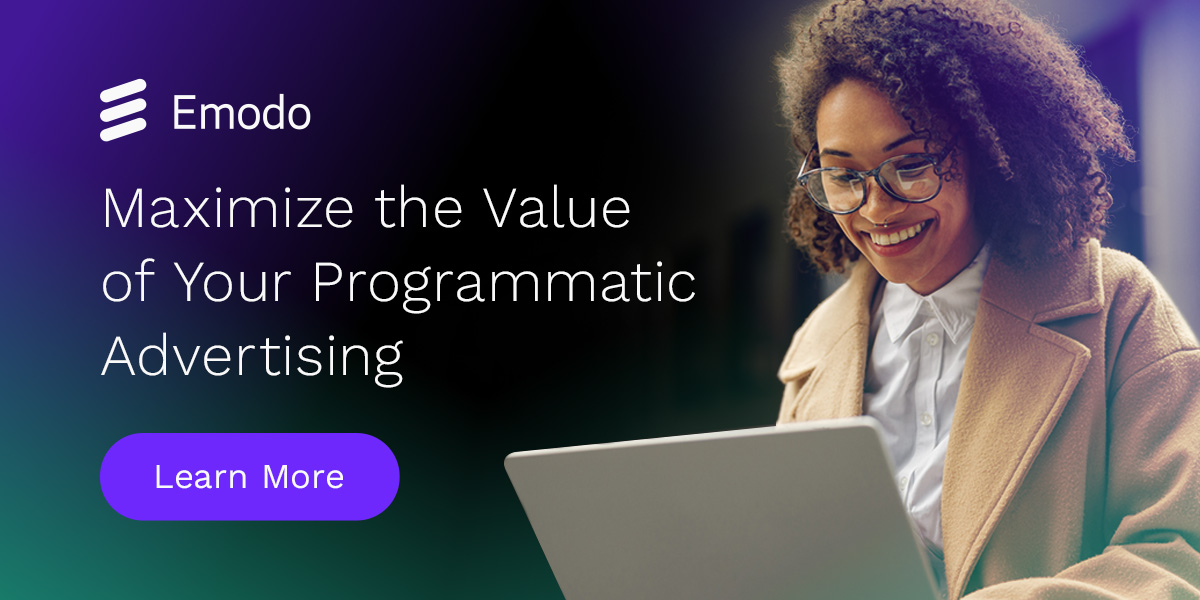Advertisers need a demand-side platform (DSP) to navigate the digital landscape wisely, as over 83% of digital ad budgets run through DSPs. By leveraging an active, discerning approach, securing a DSP to elevate programmatic advertising endeavors can be easy.
DSPs allow professionals to reach their ideal audience across various digital touchpoints. These platforms are a pivotal tool in programmatic advertising, paving the way to buy ad inventory efficiently, pinpoint specific audiences and optimize campaigns for better results. Its automation, targeting precision and real-time insights and reporting contribute to more effective and impactful digital advertising efforts.
What Is a DSP?
A DSP is a sophisticated digital advertising technology platform that enables advertisers and agencies to efficiently purchase and manage online inventory across multiple publishers, ad exchanges and platforms. This technology plays a pivotal role in programmatic advertising by automating the buying process, allowing advertisers to target specific audiences while precisely optimizing ad campaigns in real-time.
DSPs empower advertisers by enabling them to define their campaign goals and their target audiences’ demographics, interests and behaviors, then bid on ad impressions that align with these criteria. DSPs allow advertisers to make instant buying decisions through algorithms and data-driven insights, ensuring ads show to the right audience at the right time at the right place. This capability maximizes the assurance of engagement and conversions and provides other benefits:
- Access to online inventories: DSPs provide access to online inventory, from websites and apps to video and social media platforms.
- Efficient and effective: The real-time bidding and automated optimization capabilities reduce manual efforts and human slip-ups.
- Better results: Advertisers can adjust their strategies and refine campaigns based on data-driven insights to achieve better results.
- Enhanced audience targeting: Ads deliver to specific market segments and individuals, leading to higher engagement rates and a better return on investment.
- Dynamic budget allocation: The ability to track and measure campaign performance in real-time lets advertisers make informed decisions and allocate budgets wisely.

Factors to Consider When Choosing a DSP
By meticulously evaluating service providers on the necessary criteria, advertisers can select a platform that aligns with their advertising goals, enhances campaign performance and drives better results. Effective DSPs must offer seamless automation, granular audience targeting and comprehensive insights to maximize programmatic advertising success.
A platform accommodating various budget sizes can grow with the organizations’ needs and adjust expanding campaigns. A trustworthy platform will also have measures to ensure brand safety, minimize ad fraud and create a blocklist of placements that advertisers want to sidestep. While track records and client testimonials allow campaign managers to gauge effectiveness, there are other DSP evaluation criteria to consider during the search for the perfect platform:
Target Audience and Reach
One of the most important factors is the DSP’s ability to reach the right target audience. Ensure the platform can access various inventory sources, like websites, apps, CTV, where the target audience will likely spend their time. Also ensure it enables you to bring in your own first-party data. Look for advanced targeting options, such as demographic, geographic, and behavioral, as well as future-proofed options such as predictive, geo-contextual, and contextual targeting, to ensure ads display to the right people at the right time, even when IDs disappear.
Insights & Reporting
Powerful data analytics and insights allow users to track key performance indicators like return on ad spend, conversion rates and click-through rates. Real-time reporting and dashboards that provide a clear view of campaign performance and measurement are equally important, as these insights allow advertisers to make quick data-driven optimizations.
Ad Formats and Creatives
Ensure the DSP can handle the creative assets accompanying the campaign, whether display ads, video ads, CTV ads, native ads or other formats. The DSP should also support responsive and adaptive creatives to optimize for various devices and screens to enhance user experience and increase engagement. Even better? If the DSP offers unique, proprietary or exclusive formats hard to find anywhere else.
Integration and Compatibility
The DSP must seamlessly integrate with the existing ad server data, data management platforms, customer data platforms, measurement partners, and other relevant tools.
Bidding Strategies and Optimization
With real-time bidding taking place in mere milliseconds, it is vital to choose a DSP that provides flexible bidding options, like cost-per-click, cost-per-thousand or cost-per-acquisition. Look for a platform that offers automated optimization features like dynamic creative optimization and algorithmic bidding to improve campaign performance.
Fraud Prevention and Brand Safety
Evaluate the DSP’s preventative measures. A robust fraud detection mechanism and brand safety tools will ensure ads display in appropriate and reputable environments. This feature will protect brand reputation and campaign investments.
Customer Support and Training
Strong customer support, a robust help desk with training materials, or a dedicated account manager is essential for quick turnaround time to find solutions that allow advertisers to get the most out of the DSP. Training resources and documentation can prove helpful in navigating the platform adequately. The platform’s user interface is equally important to evaluate ad changes to ad optimization may require quick interference.
Ease of Use
Let’s face it, ad tech platforms can be difficult to navigate. Working with a DSP that was built for the user is incredibly important. A DSP with an intuitive user interface and user experience, as well as a seamless workflow, will enable teams, especially those with less sophisticated platform and programmatic knowledge, to be able to easily implement successful campaigns.
Price
DSPs are priced in various ways. Some require an onboarding fee, some have monthly minimums, some charge for use of data, some charge a percentage of the media campaign, and some charge for all 4, plus more! It’s smart to get an understanding of the pricing model and compare that against the amount of campaigns and campaign dollars you expect to run. Be sure to ask if there are any hidden or unexpected fees that might be applied. It’s also important to know if there are any penalties you might incur if you were to end the contract.
Steps to Choosing a DSP
By adhering to these steps, publishers and advertisers can confidently select a DSP with optimal power in a competitive market to amplify advertising impact. Begin by outlining campaign goals and target audience. Research DSPs that are renowned for robust features and data-driven capabilities, and assess their ability to handle real-time bidding and data analysis. Analyze factors like ad formats, targeting options, real-time analytics and integration capabilities with other tools.
Questions to Ask Before Choosing a DSP
How to choose a DSP that fits in with existing campaign needs comes down to asking the right questions. Scalability, global reach and support for expansion are among the most important to ensure the DSP can accommodate future growth. Additional questions to ask, which will determine whether the DSP is a good fit, include:
- Is the company a recognized innovator?
- What sort of audience targeting capabilities does the partner have, especially ID-less targeting?
- What ad formats does the partner support? Are there any unique or exclusive to them?
- How does bid optimization work?
- How will budget optimization work?
- How many daily impressions can the client expect to see?
- Does the DSP leverage machine learning (ML) and is it developed in-house?
- Is there a pilot program or sandbox testing portal you can trial before signing a contract?
Maximize the Value of Your Programmatic Advertising
Selecting a suitable DSP amid fierce competition requires a discerning approach. DSP selection must reflect authority and a keen understanding of campaign details. Prioritize a DSP that offers comprehensive reporting and analytics tools.
At Emodo, we understand that each campaign needs a tailored approach. Emodo Activate is a buying platform that helps advertisers build meaningful connections with an audience by integrating with solutions like Emodo Audiences and unique creative formats, like Emodo Adapt. Emodo’s buying platform was purpose-built with streamlined workflows and a simplified UI to make advertisers’ lives easier. Learn more about how Emodo can help strengthen your campaign’s digital reach today.
MORE LIKE THIS



